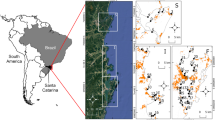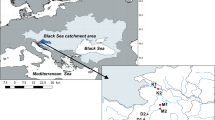Abstract
One and a half-2 1/2 year old cold living in Danish coastal waters suffer from a specific ulcer syndrome, which occurs only in waters polluted with town sewage or effluents from sugar and cellulose plants. Although the etiology of the primary lesions is unknown (virus?, stress?), the development of ulcers depends upon a bacterial infection.Vibrio anguillarum was the most common bacterium involved in both local and generalized infections in these cod.
The prevalence ofVibrio anguillarum was greater in polluted than in unpolluted areas, and the response to an outlet of wastewater from a sugar plant was an immediate increase in the number ofVibrio anguillarum in water and sediment. There was, however, no simple relationship between the prevalence ofVibrio anguillarum and the frequency of the ulcer syndrome. The observed heterogeneity among strains ofVibrio anguillarum from different localities requires a more intensive study of the taxonomy and serology of these strains.
In the future the ulcer syndrome in cod and the prevalence ofVibrio anguillarum (and other Vibrios) might be important measurements in programmes for monitoring marine pollution.
Kurzfeassung
Bei 1 1/2–2 1/2 jährigen Dorschen in dänischen Küstengewässern kommt ein spezifisches Ulkussyndrom vor, das nur in dem verschmutzten (durch Stadtabwässer, Abwässer aus Zucker- und Zellulosefabriken) Meerwasserbereich festgestellt wurde. Obwohl die Aetiologie der Primärlesionen unbekannt ist (Virus? Stress?), ist die Entwicklung zum Ulkus durch eine bakterielle Infektion bedingt. Dabei warVibrio anguillarum das am häufigsten an lokalen und allgemeinen Infektionen dieser Dorsche beteiligte Bakterium.
Vibrio anguillarum kam häufiger in verschmutzten als in nicht verschmutzten Bereichen vor, und die Reaktion auf einen Zufluss von Abwasser aus einer Zuckerfabrik war eine sofortige Zunahme der Menge anVibrio anguillarum in Wasser und Sediment. Es bestand jedoch keine lineare Beziehung zwischen dem Vorkommen vonVibrio anguillarum und der Häufigkeit des Ulkussyndroms. Die beobachtete Heterogeneität bei den an verschiedenen Orten auftretenden Arten vonVibrio anguillarum macht eine intensivere taxonomische und serologische Untersuchung dieser Arten erforderlich.
Voraussichtlich könnten das Ulkussyndrom beim Dorsch und das Vorkommen vonVibrio anguillarum (und anderer Vibrios) in Zukunft wichtige Parameter bei überwachungsprogrammen für Meerwasser sein.
Resume
Il existe, chez les morues agées de 1 1/2 a 2 1/2 ans vivant dans les eaux côtières danoises, un syndrome spécifique d'ulcère qui n'est signalé que dans les eaux de mer polluées (eaux résiduaires urbaines, effluents d'usines de fabrication de sucre et de cellulose). Bien que l'étiologie des lésions primaires soit inconnue (virus? tension?), on sait que l'évolution en ulcères est liée à une infection bactérienne et leVibrio anguillarum est la bacterie la plus couramment recontrée dans les infections tant locales que generalisées chez les morues.
La présence deVibrio anguillarum est plus fréquente dans les zones polluées que dans les zones non polluées et une décharge d'eaux résiduaires provenant d'une fabrique de sucre entrâine une augmentation immédiate du nombre desVibrio anguillarum dans l'eau et les sédiments. Toutefois, il n'y a pas de rapport simple entre la présence deVibrio anguillarum et la fréquence du syndrome d'ulcère. L'hétérogenéité des differentes souches de V. a. trouvées dans differents endroits exige une étude plus approfondie de la taxonomie et de la sérologie de ces souches.
Virbio anguillarum (et autres Vibrios) pourraient être, à l'avenir, des paramètres importants dans les programmes de mesure de la pollution chez les recepteurs marins.
Riassunto
Fra i merluzzi di un anno e mezzo-due anni e mezzo di età viventi lungo le coste danesi si riscontra una sindrome ulcerosa specifica rilevabile esclusivamente in ambienti marini inquinati (acque luride, scarichi di zuccherifici e impianti per la produzione di cellulosa). Benché l'eziologia delle lesioni primarie sia ignota (virus? stress?), la degenerazione ulcerosa è dovuta a infezione batterica. Il batterio associato più frequentemente alle infezioni, sia localizzate che generalizzate, dei merluzzi in parola èVibrio anguillarum.
Il grado di diffusione diV. anguillarum à superiore nelle zone inquinate, e l'emissione di liquami da uno zuccherificio porta ad un aumento immediato del numero diV. anguillarum presenti nell'acqua e nel sedimento. Non esiste, tuttavia, un rapporto diretto fra il grado di diffusione di questo microorganismo e la frequenza della sindrome ulcerosa. L'eterogenicità osservata fra i ceppi diV. anguillarum provenienti da diverse località richiede uno studio piu approfondito della tassonomia e sierologia di tali ceppi.
E' prevedibile che in futuro la sindrome ulcerosa del merluzzo ed il grado di diffusione diV. anguillarum (e. di altri vibrioni) possano divenire parametri importanti per i programmi di monitoraggio dell'ambiente marino.
Similar content being viewed by others
References
Anderson, J.I.W. and Conroy, D.A., 1970.Vibrio disease in marine fishes. In S.F. Snieszko (ed.). A symposium on diseases of fishes and shell fishes. Amer. Fish. Soc. Publ. 5. Washington D.C., 266–272.
Bagge, J. and Bagge, O., 1956.Vibrio anguillarum som arsag til ulcussygdom hos torsk (Gadus callaris, Linne). Nord. Vet. Med. 8: 481–492.
Evelyn, T.P.T., 1971. First records of Vibriosis in pacific Salmon cultured in Canada and taxonomic status of the responsible bacteriumVibrio anguillarum. J. Fish. Res. Bd. Can. 28: 517–525.
Egidius, E. and Andersen, K., 1975. Smaseidøden i 1974 — Vibriose. Fiskets Gang, 22: 362–364.
Hine, P.M., 1974. Diseases of Cultured Species: Proceedings of the Fish Disease Seminar. Fisheries Research Division. Occasional Publication no. 7, 15–20.
Hastein, T. and Holt, G., 1972. The occurrence ofVibrio disease in wild Norwegian fish. J. Fish. Biol. 4: 32–37.
Hastein, T. and Gjerde, J., 1975. Vibriose hos fisk. Arsak, virkning, behandling og näringsmiddel-hygiejniske forhold. Fiskets Gang, 22: 135–140.
Jensen, N.J. and Larsen, J.L., 1976. Forskningsprojekt vedrørende marine vibriopopulationers forhold til forureningskomponenter, isär kulhydratforurening i marine biotoper. Dansk Vet. Tidsskr., 59: 521–524.
Larsen, J.L. and Jensen, N.J., 1977. AnAeromonas species isolated from ulcer-disease in the cod (Gadus morhua). Nord. Vet. Med., 29: 199–211.
Rødsäther, M. C. and Raa, J., 1977. Characterization of a fish skin mucus enzyme, which causes lysis of gram nengative bacteria. J. Gen. Microbiol. to be published.
Sindermann, C. S., 1977. Recent data on possible associations of coastal/estuarine pollution with fish and shellfish diseases. International Council for the Exploration of the Sea. Fisheries Improvement Committee, pp. 32.
Author information
Authors and Affiliations
Rights and permissions
About this article
Cite this article
Larsen, J.L., Jensen, N.J. & Christensen, N.O. Water pollution and the ulcer syndrome in the cod (Gadus morhua). Vet Res Commun 2, 207–216 (1978). https://doi.org/10.1007/BF02291450
Issue Date:
DOI: https://doi.org/10.1007/BF02291450




